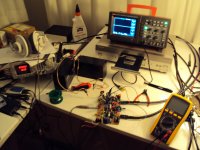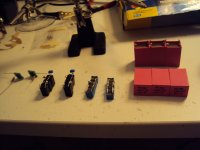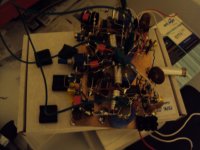Bravo Joachim. Wasn't expecting less than good third party testimonials.
We listened to Joachims units on my system consisting of a predecessor of my paX error correction amp (in fact this is the amp that was tested by Hiraga in 1998 in La Nouvelle Revue du Son and got 39.5 points out of 40).
Speakers were vintage Martin Logan Sequell II's, response-corrected via an Australian DEQX PDC 2.6.
Joachim is very meticulous about taking care of his vinyl and there was an almost total absense of any ticks or pops or surface noise. I like my music clear, clean, analytic, strong bass and no coloration, and that is the reason that I often am disappointed by records. Not this time though; it was as clean and with strong, articulated bass as I could wish. And this was not a high-end turntable!
I attributed it to the combination of Joachims excellent electronics and the very good cartidge (a Lyra Helicon).
Edit: forgot to say: there was NO noise audible, nothing, nada, zilch. Very good design!
My subjective impressions
jd
JG Headphone Amp Final Edition
Thanks again Jan. Record care is very important and part of the hobby. Send the record back to the seller if it is not ok.
I promissid compleet information about my Headphone Amp and here it comes.
I did some further tweeking but this will be the final edition for some time.
My audiophile ears where very happy with the sound of the PSG buffer but my engineer brain was not totally happy with the distortion measurements. Usually i go for -80dB or even -100dB so i redigned the buffer, the biggest source of distortion in the original version. I now use a modern form of the JLH buffer that should measure much better.
The parallel symmetric nature surpresses second harmonic and the bipolars bootstrap the fets and provide lokal feedback. This circuit is also much cheeper to make then the costly Linear Systems double Fet i was using.
I raised the output idlle current to 50mA. I build little cooling plates from 5cent pieces.
The output transistors run quite hot now so tomorrow i ad a second plate to each transistor.
The AKG701 now sings smoothly. The circuit can deliver 3V in class A into that can.
The 701 does 105dB with 1V so i think this is ample.
The JG Headphone Amp can deliver 150mW in class A and the AKG701 can stand 200mW of max power so i think it is a good match.
The output trasistors have to transfer 0,6W each into heat for that performance.
I am very happy with that design now. It sounds clear, dynamic and smooth, very good for late night listening.
On the photo i am posting you also see my new home mini lab.
I got a little 40MHz digital scope and a 20Mhz generator.
I can measure distortion with my Praxis system on my laptop but only down to -90dB.
I use an M-Audio Transit soundcard because of portablity but that limits resolution.
Dos anybody know a better portable soundcard that does better then that ?
Thanks again Jan. Record care is very important and part of the hobby. Send the record back to the seller if it is not ok.
I promissid compleet information about my Headphone Amp and here it comes.
I did some further tweeking but this will be the final edition for some time.
My audiophile ears where very happy with the sound of the PSG buffer but my engineer brain was not totally happy with the distortion measurements. Usually i go for -80dB or even -100dB so i redigned the buffer, the biggest source of distortion in the original version. I now use a modern form of the JLH buffer that should measure much better.
The parallel symmetric nature surpresses second harmonic and the bipolars bootstrap the fets and provide lokal feedback. This circuit is also much cheeper to make then the costly Linear Systems double Fet i was using.
I raised the output idlle current to 50mA. I build little cooling plates from 5cent pieces.
The output transistors run quite hot now so tomorrow i ad a second plate to each transistor.
The AKG701 now sings smoothly. The circuit can deliver 3V in class A into that can.
The 701 does 105dB with 1V so i think this is ample.
The JG Headphone Amp can deliver 150mW in class A and the AKG701 can stand 200mW of max power so i think it is a good match.
The output trasistors have to transfer 0,6W each into heat for that performance.
I am very happy with that design now. It sounds clear, dynamic and smooth, very good for late night listening.
On the photo i am posting you also see my new home mini lab.
I got a little 40MHz digital scope and a 20Mhz generator.
I can measure distortion with my Praxis system on my laptop but only down to -90dB.
I use an M-Audio Transit soundcard because of portablity but that limits resolution.
Dos anybody know a better portable soundcard that does better then that ?
Attachments
Self Pre
I started to build my version of the Self phonostage.
First, the circuit i posted had two errors : i forgot one 10nF cap and i called a 47kOhm resistor a 200 Ohm. Sorry, the version posted now corrects this errors.
I will use the JLH buffer and because i can not let good enough, good enough i will try darlingtons this time with potentially even less distortion.
I am not sure if i need the servo still but i kept it in the diagramm.
First i build the filter banks and the good news is that the Self trick works. Paralleling several caps with 1% tolerance gives a cap with better then 0.5% tolerance.
The 10nf´s added to absolutely the same value ( 49nF ) , bejond my measurement limit and the 4.7nF bank was better then 0.5%.
I lowered the corner frequency of the subsonic filter to 14Hz / -3dB.
John will recocknise the famous pink Röderstein MKC as used in vintage Mark Levinson equipment.
I also found some "real" cooling profiles for my headphone amp.
I will install them and listen a bit before i go to bed.
I started to build my version of the Self phonostage.
First, the circuit i posted had two errors : i forgot one 10nF cap and i called a 47kOhm resistor a 200 Ohm. Sorry, the version posted now corrects this errors.
I will use the JLH buffer and because i can not let good enough, good enough i will try darlingtons this time with potentially even less distortion.
I am not sure if i need the servo still but i kept it in the diagramm.
First i build the filter banks and the good news is that the Self trick works. Paralleling several caps with 1% tolerance gives a cap with better then 0.5% tolerance.
The 10nf´s added to absolutely the same value ( 49nF ) , bejond my measurement limit and the 4.7nF bank was better then 0.5%.
I lowered the corner frequency of the subsonic filter to 14Hz / -3dB.
John will recocknise the famous pink Röderstein MKC as used in vintage Mark Levinson equipment.
I also found some "real" cooling profiles for my headphone amp.
I will install them and listen a bit before i go to bed.
Attachments
I promissid compleet information about my Headphone Amp and here it comes.
Thank you Joachim.
Having now lived on a diet of vinyl for a long time listening to headphones and CD was quite shocking. Many productions are simply unlistenable in the treble. First i thought there was something wrong with my Headphone or Headphone Amp but good sounding material like Patricia Barber or Kari Bremnes told me otherwise.
What is very typical for this Headamp-Headphone combination is tremendoes bass depth and dynamics. Think about it, it is a direct coupled servoless circuit. It really goes down to DC. If the CD is well made the sound is open in the midrange with a lot of detail resolution in the treble. Some pieces of music come over totally different then over more forgiving and distorted speakers. I found that speakers, even very good one often have a resolution problem. For example on "Older" from George Michael i heard an intrument that made an important intro that i did not know over spaekers of any construction, even ribbons and electrostatics.
Well, it´s a learning curve and i certainly will listen to vinyl also over headphones.
The Headphone Amp goes clean and loud with the 701 so in that sense i am satisfied.
Let´s see if i can do something in the treble or if i have to simply except that fact.
What is very typical for this Headamp-Headphone combination is tremendoes bass depth and dynamics. Think about it, it is a direct coupled servoless circuit. It really goes down to DC. If the CD is well made the sound is open in the midrange with a lot of detail resolution in the treble. Some pieces of music come over totally different then over more forgiving and distorted speakers. I found that speakers, even very good one often have a resolution problem. For example on "Older" from George Michael i heard an intrument that made an important intro that i did not know over spaekers of any construction, even ribbons and electrostatics.
Well, it´s a learning curve and i certainly will listen to vinyl also over headphones.
The Headphone Amp goes clean and loud with the 701 so in that sense i am satisfied.
Let´s see if i can do something in the treble or if i have to simply except that fact.
Electrostatics
Hi Joachim,
Thanks again for shearing this with us.
This intro in older from George Michael, is one of the little things that a good (read: well constructed ) ESL electrostatic loudspeaker can let you hear even at low volumes.
As soon as my new ESL is ready, I'll let you know so you can come and listen to it and perhaps that it is possible to hear such an intro via loudspeakers. At least so I hope.
I'm also going to bed now, it's past 4 am all the best and do yourself a favor be cautious with headphones volume, you can get rearing problems by playing to loud!
all the best and do yourself a favor be cautious with headphones volume, you can get rearing problems by playing to loud!
I always listen to my STAX on moderated power, so that I can hear the ambient sound through my headphone, that way I know that I never play to loud. (e.g. a ticking clock)
Take care.
Best regards,
Audiofanatic (José)
Hi Joachim,
Thanks again for shearing this with us.
This intro in older from George Michael, is one of the little things that a good (read: well constructed ) ESL electrostatic loudspeaker can let you hear even at low volumes.
As soon as my new ESL is ready, I'll let you know so you can come and listen to it and perhaps that it is possible to hear such an intro via loudspeakers. At least so I hope.
I'm also going to bed now, it's past 4 am
I always listen to my STAX on moderated power, so that I can hear the ambient sound through my headphone, that way I know that I never play to loud. (e.g. a ticking clock)
Take care.
Best regards,
Audiofanatic (José)
I many times advocated the ''headphones check''. Check your new speakers in your room against headphones at least for correct tone I say. Its something intuitive in studio practice. Ribbons and ESLs and low coloration coil speakers have resolution, but the headphones lack the room's masking. Cochlea integrates longer in the modal region and bass reverberation in room masks high up in the mids. Headphones are speakers after all. But personal speakers. The ''in the centre of my my head effect'' isn't normal, but to check resolution and correct tone, they are indispensable. Some Japanese cart masters check tuning with Stax.
Having now lived on a diet of vinyl for a long time listening to headphones and CD was quite shocking. Many productions are simply unlistenable in the treble. First i thought there was something wrong with my Headphone or Headphone Amp but good sounding material like Patricia Barber or Kari Bremnes told me otherwise.[snip]
My thoughts exactly. I am now at a point where I never buy any CD's from recordings past 2000, unless I really give them a good listen. The best CDs were recorded, loosely speaking, in the 90's. Not overmixed, not compressed, dynamic. That's the attractiveness of vinyl for me, the music is often so much better, even if it technically is not as accurate as a CD chain.
Maybe I should buy a turntable again...
jd
Good turntables are not expensive any more.
For example Clearaudio and Rega make good packages of turntable, arm and cart. for
1000,- - 2000,-€. Later a better cart. can be added.
There is also a lot of good stuff on the used market.
Errata : Ikoflexer found a small mistake in circuit post 1088.
The LME49713 op amps PSU connection is reversed. Pin 4 should go to - supply and pin 7
should go to + supply of cause.
For example Clearaudio and Rega make good packages of turntable, arm and cart. for
1000,- - 2000,-€. Later a better cart. can be added.
There is also a lot of good stuff on the used market.
Errata : Ikoflexer found a small mistake in circuit post 1088.
The LME49713 op amps PSU connection is reversed. Pin 4 should go to - supply and pin 7
should go to + supply of cause.
Fortunately the LME49710 is so low in distortion the way i use it ( shunt feedback) that it is barely distinguishable from the generator.
Any improvements will be difficult and there is discreet and hybrid of cause.
BB and AD put a lot of interesting stuff out recently and there are OPs that are developed for other purposes like video that are great for audio too so i am a bit more optimistic about the future of good sound.
Any improvements will be difficult and there is discreet and hybrid of cause.
BB and AD put a lot of interesting stuff out recently and there are OPs that are developed for other purposes like video that are great for audio too so i am a bit more optimistic about the future of good sound.


